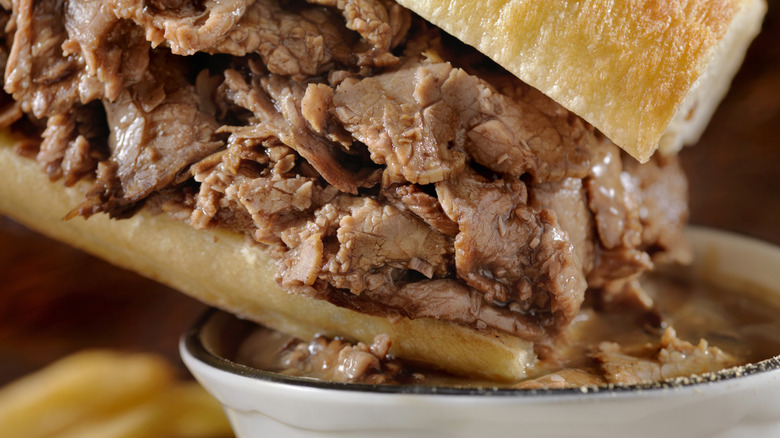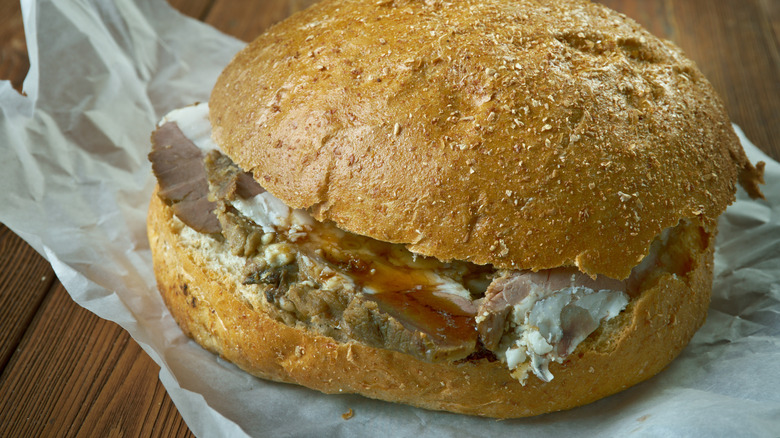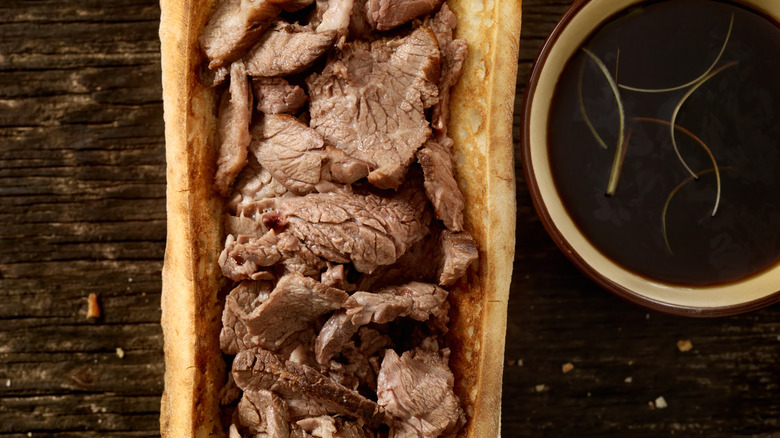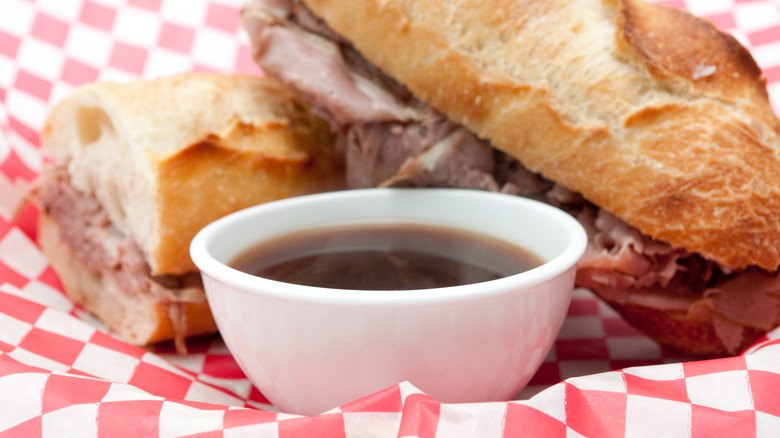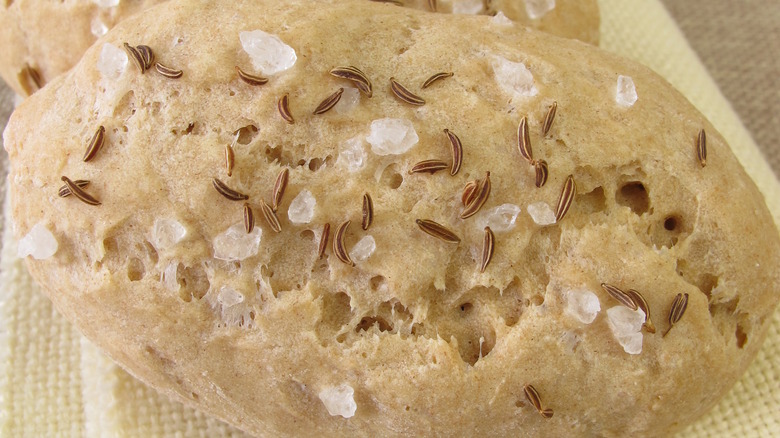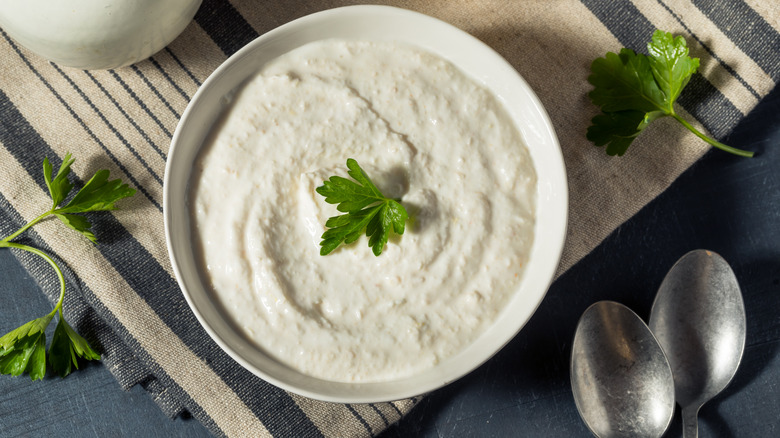The Difference Between Beef On Weck And A French Dip Sandwich
Beef on weck and a French dip are essentially the same sandwich, right? Both feature hearty bread, thinly sliced roasted beef, and savory jus from the cooking of said beef. But don't come after us Buffalonians or Angelenos; we know good and well that these two iconic sandwiches have unique differences that make them beloved in their own rights. To imply any different would be like saying a chicken sandwich from Burger King is the same as one from Chick-fil-A.
There are a plethora of regional beef sandwiches in the U.S., from Chicago's dripping Italian beef to Baltimore's smoky pit beef. Yet beef on weck and the French dip stand out for their austerity, which is not to say that either is boring. Rather, these sandwiches are celebrations of beef — with important supporting players, to be sure. The French dip is, obviously, the most famous of the two. You can order a version of this sandwich from restaurants across the country — a testament both to its delectable nature and the relative ease with which it can be made. Beef on weck is lesser known, which is a shame but understandable. Though, it was once a tentpole menu item at Buffalo Wild Wings, which used to be called Buffalo Wild Wings & Weck, giving rise to the still-heard moniker BW3s. A staple of the culinary scene of New York state's "other" city, beef on weck, like so many American foodstuffs, tells the tale of immigration and its influence on our culture.
What is beef on weck?
Buffalo is a burly city, as it has to be lying on the far eastern shore of Lake Erie, buffeted by icy winds and driving snow for the better part of the year. As such, its famous foods are the kind of fare that help a body withstand the elements. Of course, when anyone thinks of Buffalo and food, they think of chicken wings, a perfect, meaty, spicy example of what we're talking about. But, you don't always want a bone in your food, and chicken wings aren't exactly clean eating. A beef on weck is tidier, if only a bit.
A sandwich's filling is the star of the show, some would say, and a beef on weck has a showstopper in its pile of perfectly medium-rare roast beef. It's right there in the name, but so is weck, a word that leaves some scratching their head. Short for kummelweck, weck refers to the sandwich's indispensable bun covered in coarse salt and zingy caraway seeds. Without a kummelweck roll and its contributions to the sandwich's overall flavor and texture, you'd just be having beef on bread. Yet, a sandwich also needs a condiment, and a beef on weck features one that is not to be outdone. Bringing the heat in the way only it can, horseradish is slathered on, slicing like a pungent knife through the richness and starch. Beef on weck also comes with beef jus, but we'll touch on that more later.
What is French dip?
From Buffalo we head west to Los Angeles, home to many fine foods, but two restaurants in particular both claim to have invented one sandwich. Phillipe's and Cole's each argue it originated the French dip sandwich. Food rivalries are fun, but the due diligence has been done, and all signs point to Phillipe's being the birthplace of the sandwich.
And what a sandwich it is. If you like pure, unadulterated beef, then you probably already gravitate toward this sandwich. Dripping medium-rare roast beef is tucked inside a crusty French roll and served with a wide-mouth cup of beef jus for dipping. The jus underlines the beefiness of it all and softens the bread just enough. Every bite explodes in the mouth akin to a savory Gusher. Of course, some people put cheese on a French dip, some add peppers and onions, and still others forgo the beef in place of lamb, pork, or turkey. But the real deal is bovine through and through.
It is worth noting that Phillipe's — home of the French dip, or dipped as they say — serves the above variations on a beef French dip and will put cheese on any of them. The eatery also dips the sandwich for you. So, maybe our collective understanding of a French dip is faulty, but we'll leave the epistemology for another day and just go with the beef version served au jus for the sake of this comparison.
Beef on weck doesn't get dunked
On the application of jus, the French dip and the beef on weck diverge, but they are similarly derived. A large cut of beef — usually a lean and economical cut like top loin roast or sirloin — is roasted with beef broth and possibly vegetables like mirepoix with garlic and fresh herbs like thyme. When it is medium rare, the beef is thinly sliced, but all of that flavorful broth that has gained strength from the meat and via reduction is put to good use.
The jus for a beef on weck is not typically delivered to diners in a cup with the meat. Before serving, the cut side of the top bun of the kummelweck roll is dipped in the jus, sponging up just enough to moisten the sandwich without it being a complete mess. Dunking a beef on weck would surely dilute the pungency of the horseradish sauce spread on the bun and certainly wash away the crucial grains of salt and caraway seeds clinging to the bun. In short, it would be an affront.
This isn't a problem for the French dip. With nothing but beef and French bread in sight, diners are free to dunk and dunk again to their stomach's delight. You become the master of your own gustatory destiny with the French dip as you choose to go for a light rinse of jus or a full bath.
French dips require French bread
We have Germany to thank for the kummelweck roll. Kummel means "caraway" and weck means "roll," and these buns are a variation on the German kaiser roll. Buffalo has long hosted a large population of German immigrants who brought their traditional foodways to the city, including baked goods. You can still find the rolls at bakeries throughout Buffalo and western New York. Feel free to stuff them with roast pork or sliced turkey if the spirit moves you, just don't try to make a beef on weck without one.
Speaking of bread, is a French dip French? It was created by a Frenchman — Phillipe Mathieu, at his eponymous restaurant — but you likely won't find it on menus in France. However, the bread is certainly a nod to Gallic baking. Though not quite a baguette, the French roll for the French dip is still integral to its construction. It must be crusty enough to hold tight against the onslaught of dunking, yet with an airy crumb that ably absorbs the meaty jus. Soft and light breads don't stand a chance, while buns that are too sturdy offend the very spirit of a French dip.
Hold the horseradish for a French dip
Horseradish is divisive. Some people don't like its pungent, sinus-clearing type of heat, yet others clamor for it. Less of a fiery sensation, the punch of strong horseradish is almost acidic, gripping the whole of the palate and demanding to be acknowledged. That's what makes it such a good pairing with rich, savory beef. On a beef on weck, the horseradish (which is given sauce form with the addition of mayonnaise, sour cream, or both) adds a high note to the bassy beef and baritone bread.
Does that mean a French dip is wrong to not include horseradish? No, it's just different. There are times when the stomach wants a harmony of flavors, and there are times when it just wants to get to the heart of the matter. French dips offer no distraction from the meat. Though carnivorous connoisseurs may take umbrage at the insinuation, a French dip is not unlike a steak. Yes there's bread and broth, but the message is clear: The beef is boss.
